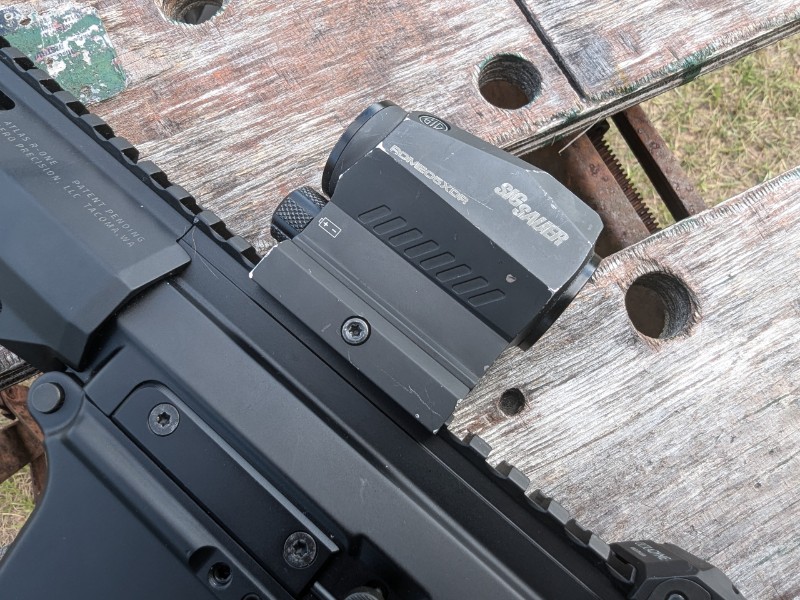Sig Sauer ROMEO5 Gen 1 vs Gen 2: A Comparison

Sig Sauer produces a confusing number of optics with a variety of numbers assigned to differentiate them. The numbers don’t necessarily matter, and just like Glock, they are a simple way to label the optics rather than any indicator of their size, quality, or design. The ROMEO red dot series is no different, with the most popular model being the ROMEO5.
The ROMEO5 is a step above the MSR series but isn’t quite up there with the ROMEO4 or ROMEO8. The ROMEO5 famously retails for less than $200 and consistently performs well above its price point. They are my favorite budget optics and are the options I suggest to new gun owners just looking for a simple optical option.
Sig Sauer recently quietly released a Gen 2 to the famed ROMEO5 series. As an owner of more than one ROMEO5, I was excited to see how the new generation of ROMEO5s compared to the older generation. Let’s dig in and see if the ROMEO5 Gen 2 should replace all the Gen 1s on your guns.
A Common Denominator
The differences between the Gen 1 and Gen 2 ROMEO5s aren’t massive. They are both compact optics that are roughly the same size as the Aimpoint micro-optics. This size has dominated the red dot market and is essentially the standard. The optics are both 20mm red dots designed for long guns.
Both optics feature proprietary MOTAC technology, which automatically powers down the unit if left alone and idle for 120 seconds. When the optic senses motion, it springs back to life at the last brightness level. It’s a nice hands-free feature, for sure. Both optics have a standard 2 MOA dot option, although there are additional reticles for Gen 1.
When it comes to practical application, the average shooter isn’t going to notice a big difference between the two optics. You’ll be able to zero the optics easily, get them on target, and they’ll last a long time as long as you don’t take a hammer to them.
That doesn’t mean they are a perfect 1:1 comparison, and the Gen 2 upgrades shouldn’t be considered. The slight differences and variances can create seemingly big differences for users who might be pickier about their optics selection.
Gen 1 vs Gen 2
As a man who owns three ROMEO5 Gen 1 optics, I know the optic inside and out. The Gen 2 is still new to me, but it has proven impressive. Comparing the two, it seems like Sig Sauer doesn’t intend to replace the Gen 1s just yet but simply wants to provide a different option for more selective shooters with the Gen 2.

Models and Options
Right off the bat, the ROMEO5 Gen 1 has way more model options. It has the standard model, the XDR, the Predator, and a few dealer-specific models, like the OPMOD variant and the Tread model. Sig Sauer has spread the ROMEO5 around like America spreads democracy. It can be tough to make a one-for-one comparison, so I’ll focus on the standard ROMEO5 Gen 1 and the XDR when comparing it to Gen 2.
Mounting Differences
One of the biggest differences is the mounts. Sig Sauer built the ROMEO5 Gen 2 to be a one-piece design. The optic and mount are one solid piece of metal. The Gen 2 design replicates the XDR series of ROMEO5 red dots. The standard ROMEO5 Gen 1 uses an Aimpoint Micro footprint.
The standard Gen 1 allows the user to quickly alternate the height by using different mounts. Shooters can choose between various low and high mounts, making it easy to mount the optic on ARs, AKs, Scorpions, and more.

Changing heights is quite nice, especially if you use something other than an AR-based weapon or for night vision use. The original ROMEO5 can also be used as an offset or backup optic to a magnified optic.
The benefit of the Gen 2 optic is durability. One solid optic introduces fewer failure points, and it’s simply not reliant on small screws for staying tight on the gun. The ROMEO5 Gen 2 uses a huge nut and bolt that acts like a third recoil boss. This nut and bolt is much larger than the standard ROMEO5 and XDR size.

The design allows you to torque it down to 65-inch pounds. Sig’s design provides a massive clamping surface, and the optic locks down on your weapon. Removing it, or even breaking it loose, requires a significant amount of effort so it won’t easily lose zero or loosen up over time.
Turrets
The Gen 2 turrets also follow the XDR design. They are slightly recessed into the optic’s body and use a flat-head tool. Unlike the Gen 1, there are no capped turrets, but they aren’t needed. Operationally, the only difference is that Sig kicked up the tactile feel of the turrets with the Gen 2. The Gen 1 turrets are fine, but the Gen 2 provides much more tactile and audible feedback.
Buttons
There are some button differences. Both generations use top-mounted, ambidextrous buttons. The differences are slight. Gen 2 provides more feedback per press, and it’s easy to feel and engage with. The Gen 1 buttons are slightly more recessed and require more effort to press and activate.

Clarity
The Gen 2 delivers slightly better clarity. The notch filter is less aggressive, and the glass is clearer with the Gen 2. The Gen 1 features a slightly darker notch filter that gives the optic that blue tint.
The Gen 2 series uses a bottom-mounted battery compared to the Gen 1’s side-mounted battery compartment. This creates less obstruction in your two-eyed, open-sight picture. It’s small but worthwhile. The Gen 1 ROMEO5 XDR series uses the same type of bottom-mounted battery.
Battery
The Gen 2 uses a AAA battery with 50,000 hours of battery life, while the ROMEO5 uses a CR2032 battery with only 40,000 hours of battery life. The XDR series can also use a AAA battery with the same battery life—a small but notable difference worth noting.
Performance Differences
We don’t see a big difference between the two optics in action. One isn’t drastically better than the other. The Gen 2 has two additional daylight brightness settings, but I only use setting eight, even in the brightest light. The 2 MOA dots appear identical without a big difference in emitter clarity.

I’ve used the optics in varying light conditions and detected no noticeable difference. This includes bright daylight, dusk, early morning, and under-white mounted weapon lights. I even viewed both through an NVG monocular, and neither is that great under NVGs, but it’s not unusable either. Both optics maintained zero after several drops and feature IPX7 waterproof ratings.
As much as I’d love to say the Gen 2 is revolutionary, it’s just a microevolution of the Gen 1. The Gen 1 already offered a downright excellent optic, and there wasn’t much to change. These days, a basic Gen 1 can be found for around $130 for the base model. The XDR seems to sell for closer to $200. The Gen 2 falls right in the middle at around $160.
Which One?
If you want a more modular optic, the SIG ROMEO5 Gen 1 allows you to pick various mount heights, which allows it to work on guns outside of ARs or in backup optic roles. The Gen 2 gives us a more durable optic with a piece mount for less money than the Gen 1 XDR, but with only one reticle. This is why I don’t think the Gen 1s are being replaced just yet. The XDR series seems to be replaced with a slightly cheaper but better-made option.
Which would you pick? Let us know below!
The post Sig Sauer ROMEO5 Gen 1 vs Gen 2: A Comparison appeared first on The Mag Life.
Read the full article here






